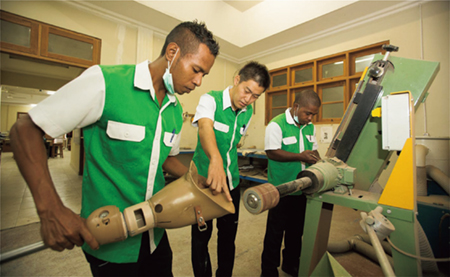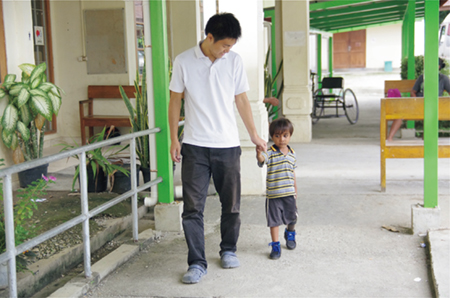Stories from the Field 02
Providing People in Need with Advanced, Custom Made Prosthetics and Orthotics
– The Challenges of One Prosthetist in Timor-Leste
Timor-Leste gained independence in 2002, and today about 1.18 million people live in this country roughly the same size of Iwate Prefecture in Japan. Since its independence, Timor-Leste has achieved GDP growth rate in excess of 4% underpinned by its abundant resource related income streams mainly from petroleum and natural gas. However, because of its undeveloped medical infrastructure, people have no easy access to medical facilities. The country has extremely low standards of healthcare due to a shortage and low quality of qualified healthcare professionals.
There are a number of people living in Timor-Leste who face difficulties in their daily lives due to loss of limbs caused by injuries during the war of independence, illnesses, traffic accidents, or other accidents. Especially in rural areas, some people have even lost their limbs by crocodile attacks. Yet, there were only five qualified prosthetists and orthotists, including assistants, in the entire country who were capable of providing artificial limbs to these people or orthosis to others suffering from sequela of spinal cord injuries, cerebral infarction, etc.

Mr. Miyata instructing colleagues regarding the fabrication process (Photo: Yusuke Miyata)
Mr. Yusuke Miyata, who is a licensed prosthetist, was dispatched to the National Rehabilitation Centre (NRC) of Timor-Leste in July 2016 as a Japan Overseas Cooperation Volunteer. The NRC, located in the capital of Dili, is the only rehabilitation center in the country. Every person requiring prosthetics and orthotics in Timor-Leste receives treatment at the NRC.
NRC staff members also visit rural communities outside the capital of Dili, where they identify people in need of care whom they then provide with appropriate rehabilitation after diagnosis at the NRC, including the provision of prosthetics and other fittings. Mr. Miyata describes his first impression of the NRC and its services as follows: “I have now five colleagues at the NRC, so including myself, we are a team of six. Honestly speaking, when I first arrived at the NRC I found the quality of the prosthetic devices very low. For example, one patient could not walk because of the pain caused by their prosthetic, which did not fit correctly, but the cause was determined to be the patient's leg and not the device. So, I began teaching my colleagues from the basics such as the fact that they could fix the problem technically, and since then, I have been instructing them about prosthetic device techniques as we work together.”
Mr. Miyata's work begins with hearing from patients, and after identifying the extent of their injury or paralysis, he fabricates the right device for them. He also makes adjustments to the devices of previous patients based on changes in their physical condition. A patient who has lost his limb in a traffic accident will experience muscle atrophy and other symptoms about in a week afterward, which causes slight changes in the diameter and shape of the limb's connection to the device. Therefore, it is critical that devices are fabricated in a short period of time. Mr. Miyata can make some devices that would require his colleagues one month to fabricate in as little as two or three days. Mr. Miyata has fabricated more than 100 new prosthetic devices during his stay for roughly 10 months in Timor-Leste (as of May 2017). He has come up with a number of unique, patient-first innovations, such as opening holes in devices to improve the breathability for ventilation given Timor-Leste's hot climate. His work, supported by finely tuned and advanced techniques, is highly appreciated by a number of prosthetic and orthotic patients and has been highly recognized by local healthcare professionals. Mr. Miyata, though, also points out there are issues unique to Timor-Leste.

Mr. Miyata helping a child to practice walking with his prosthetic leg (Photo: Yusuke Miyata)
“One of the biggest issues in Timor-Leste is people's awareness to medical care. People have a habit of going to a hospital immediately when you are sick or injured. Traditional medicine is deeply rooted in the country. Each community has a shaman-like person who practices traditional medicine, so if someone breaks his bone, for example, he is likely to receive only an ointment from the shaman as treatment. Actually, one of the staff members working with me broke his bone the other day and he tried to use traditional medicine, even though he works in healthcare. This is why our staff members visit rural communities in search of patients who require treatment or prosthetic devices. First, I hope to make up for the delays in recovery caused by traditional treatment and then convince them that they should not be afraid of hospitals,” says Mr. Miyata.
Timor-Leste still faces a number of issues, such as changing the way people view medical care and developing new clinical technicians. Nonetheless, Mr. Miyata continues to work hard under the motto “patients first,” utilizing Japan's advanced technologies during the course of his daily support and guidance to his prosthetist and orthotics colleagues medically and technically.
<< Previous Page Next Page >>
Main Text | Statistics and Reference Materials | Stories from the Field | Master Techniques from Japan to the World | ODA Topics
